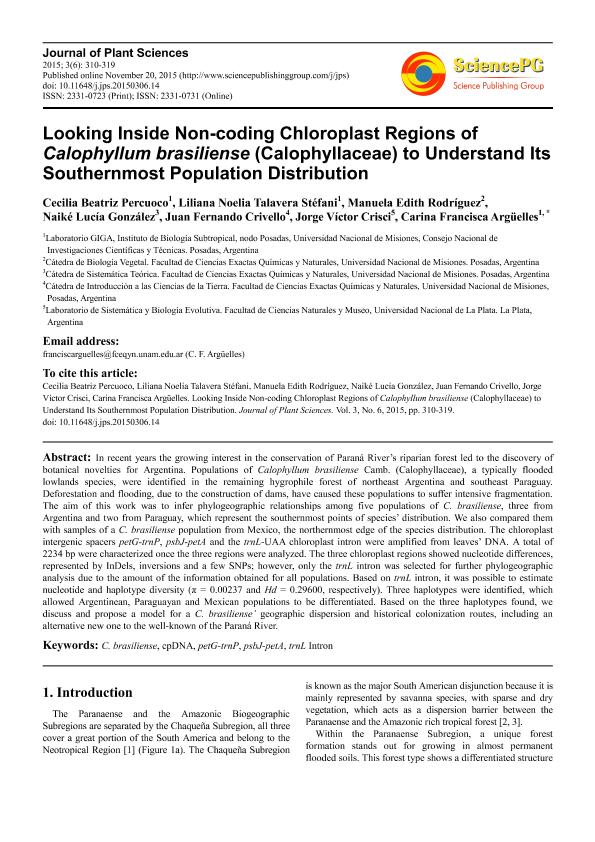Mostrar el registro sencillo del ítem
dc.contributor.author
Percuoco, Cecilia Beatriz

dc.contributor.author
Talavera Stefani, Liliana Noelia

dc.contributor.author
Rodriguez, Manuela Edith
dc.contributor.author
González, Naiké Lucía
dc.contributor.author
Crivello, Juan Fernando
dc.contributor.author
Crisci, Jorge Victor

dc.contributor.author
Argüelles, Carina Francisca

dc.date.available
2018-03-08T21:54:44Z
dc.date.issued
2015-11
dc.identifier.citation
Percuoco, Cecilia Beatriz; Talavera Stefani, Liliana Noelia; Rodriguez, Manuela Edith; González, Naiké Lucía; Crivello, Juan Fernando; et al.; Looking inside non-coding chloroplast regions of calophyllum brasiliense (calophyllaceae) to understand its southernmost population distribution; Science Publishing Group; Journal of Plant Scienc; 3; 6; 11-2015; 310-319
dc.identifier.issn
2331-0723
dc.identifier.uri
http://hdl.handle.net/11336/38354
dc.description.abstract
In recent years the growing interest in the conservation of Paraná River’s riparian forest led to the discovery of botanical novelties for Argentina. Populations of Calophyllum brasiliense Camb. (Calophyllaceae), a typically flooded lowlands species, were identified in the remaining hygrophile forest of northeast Argentina and southeast Paraguay. Deforestation and flooding, due to the construction of dams, have caused these populations to suffer intensive fragmentation. The aim of this work was to infer phylogeographic relationships among five populations of C. brasiliense, three from Argentina and two from Paraguay, which represent the southernmost points of species’ distribution. We also compared them with samples of a C. brasiliense population from Mexico, the northernmost edge of the species distribution. The chloroplast intergenic spacers petG-trnP, psbJ-petA and the trnL-UAA chloroplast intron were amplified from leaves’ DNA. A total of 2234 bp were characterized once the three regions were analyzed. The three chloroplast regions showed nucleotide differences, represented by InDels, inversions and a few SNPs; however, only the trnL intron was selected for further phylogeographic analysis due to the amount of the information obtained for all populations. Based on trnL intron, it was possible to estimate nucleotide and haplotype diversity (π = 0.00237 and Hd = 0.29600, respectively). Three haplotypes were identified, which allowed Argentinean, Paraguayan and Mexican populations to be differentiated. Based on the three haplotypes found, we discuss and propose a model for a C. brasiliense’ geographic dispersion and historical colonization routes, including an alternative new one to the well-known of the Paraná River.
dc.format
application/pdf
dc.language.iso
eng
dc.publisher
Science Publishing Group
dc.rights
info:eu-repo/semantics/openAccess
dc.rights.uri
https://creativecommons.org/licenses/by-nc-sa/2.5/ar/
dc.subject
C. Brasiliense
dc.subject
Cpdna
dc.subject
Petg-Trnp
dc.subject
Psbj-Peta
dc.subject
Trnl Intron
dc.subject.classification
Otras Ciencias Biológicas

dc.subject.classification
Ciencias Biológicas

dc.subject.classification
CIENCIAS NATURALES Y EXACTAS

dc.title
Looking inside non-coding chloroplast regions of calophyllum brasiliense (calophyllaceae) to understand its southernmost population distribution
dc.type
info:eu-repo/semantics/article
dc.type
info:ar-repo/semantics/artículo
dc.type
info:eu-repo/semantics/publishedVersion
dc.date.updated
2018-03-01T13:51:12Z
dc.identifier.eissn
2331-0731
dc.journal.volume
3
dc.journal.number
6
dc.journal.pagination
310-319
dc.journal.pais
Estados Unidos

dc.journal.ciudad
Nueva York
dc.description.fil
Fil: Percuoco, Cecilia Beatriz. Consejo Nacional de Investigaciones Científicas y Técnicas. Centro Científico Tecnológico Conicet - Nordeste. Instituto de Biología Subtropical. Instituto de Biología Subtropical - Nodo Posadas | Universidad Nacional de Misiones. Instituto de Biología Subtropical. Instituto de Biología Subtropical - Nodo Posadas; Argentina
dc.description.fil
Fil: Talavera Stefani, Liliana Noelia. Consejo Nacional de Investigaciones Científicas y Técnicas. Centro Científico Tecnológico Conicet - Nordeste. Instituto de Biología Subtropical. Instituto de Biología Subtropical - Nodo Posadas | Universidad Nacional de Misiones. Instituto de Biología Subtropical. Instituto de Biología Subtropical - Nodo Posadas; Argentina
dc.description.fil
Fil: Rodriguez, Manuela Edith. Universidad Nacional de Misiones. Facultad de Ciencias Exactas, Químicas y Naturales; Argentina
dc.description.fil
Fil: González, Naiké Lucía. Universidad Nacional de Misiones. Facultad de Ciencias Exactas, Químicas y Naturales; Argentina
dc.description.fil
Fil: Crivello, Juan Fernando. Universidad Nacional de Misiones. Facultad de Ciencias Exactas, Químicas y Naturales; Argentina
dc.description.fil
Fil: Crisci, Jorge Victor. Universidad Nacional de La Plata. Facultad de Ciencias Naturales y Museo. Laboratorio de Sistemática y Biología Evolutiva; Argentina. Consejo Nacional de Investigaciones Científicas y Técnicas; Argentina
dc.description.fil
Fil: Argüelles, Carina Francisca. Consejo Nacional de Investigaciones Científicas y Técnicas. Centro Científico Tecnológico Conicet - Nordeste. Instituto de Biología Subtropical. Instituto de Biología Subtropical - Nodo Posadas | Universidad Nacional de Misiones. Instituto de Biología Subtropical. Instituto de Biología Subtropical - Nodo Posadas; Argentina
dc.journal.title
Journal of Plant Scienc
dc.relation.alternativeid
info:eu-repo/semantics/altIdentifier/url/http://article.sciencepublishinggroup.com/pdf/10.11648.j.jps.20150306.14.pdf
Archivos asociados
